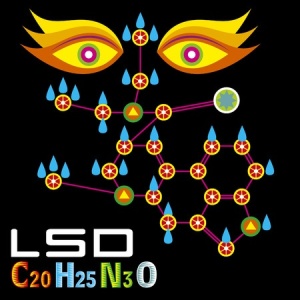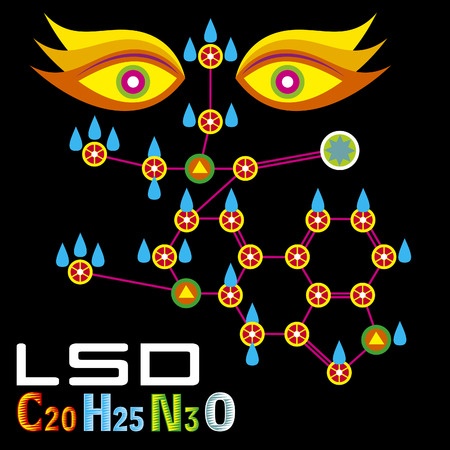
The province of Saskatchewan seems an unlikely place to give birth to “psychedelic psychiatry” (See Erika Dyck’s article, “Hitting Highs at Rock Bottom” and a review of her book Psychedelic Psychiatry), but it’s true. In October of 1951 a British psychiatrist named Humpry Osmond became the deputy director of a Canadian Mental Hospital in Weyburn, Saskatchewan. He immediately organized a biochemical research program in order to continue the work he had begun with hallucinogens while he was at St. George’s Hospital in London.
Not only did Osmond coin the term psychedelic, he seems to be among the first to hypothesize a chemical imbalance theory for both schizophrenia and alcoholism. Initially interested in the therapeutic properties of mescaline, Osmond noticed that mescaline produced reactions similar to schizophrenia. These findings led him to conjecture that “schizophrenia was caused by a chemical imbalance in the brain.” Oh, and he was a pioneer researcher into the psychotherapeutic benefits of mescaline and LSD for alcoholism and various mental health disorders.
Osmond heard of the discovery of lysergic acid (LSD) by Albert Hoffman and tried it himself. He discovered that LSD was more powerful than mescaline and that it produced profound changes in consciousness. By inducing a new level of self-awareness, Osmond theorized LSD could have therapeutic benefits for individuals suffering with schizophrenia. Some of his early volunteers in LSD experiments described this feeling as “a new sense of spirituality.”
According to Osmond’s co-researcher, Abram Hoffer, the idea to try LSD with alcoholics occurred one evening in 1953, when they thought that: “LSD experiences were remarkably similar to descriptions of delirium tremens, or the effects of an alcoholic ‘hitting bottom.’” They wondered if a controlled LSD-produced delirium would help alcoholics stay sober. In 1953, they gave LSD to two alcoholic patients. One person (a female) stopped drinking immediately and the other (a male) stopped six months later. Over the next ten years they tried this procedure on over 700 patients and claimed the results were similar to that first experiment. One of those alcoholics was Bill W., cofounder of Alcoholics Anonymous.
Bill’s involvement with LSD came about through his friendships with Gerald Heard, a British philosopher, and Aldous Huxley, author of the classic novel Brave New World. Bill had been a friend of Heard’s since 1944. He met Huxley through Heard. According to Pass It On, the A.A. book about Bill and the origins of Alcoholics Anonymous, it was Huxley who referred to Bill as “the greatest social architect of the century.”
Under the supervision of Humphry Osmond, Huxley used mescaline for the first time on May 5, 1953. Huxley’s short book about his experience with mescaline, The Doors of Perception, was published in 1954. Through Heard and Huxley, Bill was introduced to Osmond and Hoffman. At first, when Bill heard about Osmond’s work with LSD, he was “extremely unthrilled.” Bill was “very much against giving alcoholics drugs.” He became interested, though, when he heard Osmond and Hoffman were getting results.
Under the guidance of Gerald Heard, Bill took LSD for the first time on August 29, 1956. He was enthusiastic about his experience. He felt it helped to eliminate barriers that stood in the way of an individual’s direct experience of the cosmos and God. According to Nell Wing, then secretary to A.A., “He had an experience [that] was totally spiritual, [like] his initial spiritual experience.” Among the friends and family whom Bill convinced to try LSD was his wife Lois and his spiritual advisor, Father Ed Dowling. Watch a 1950s video of an LSD session and a discussion of its effects by Gerald Heard here.
In a letter he wrote to Sam Shoemaker in June of 1958, Bill said that he took LSD several times and had collected considerable information about it. He felt that the negative information about its “awful dangers” was far from the truth. He thought the experiments by early LSD researchers like Osmond and Hoffman showed it had no physical risks at all. “The material [LSD] is about as harmless as aspirin.” Presciently he said: “It would certainly be a huge misfortune if it ever got loose in the general public without a careful preparation as to what the drug is and what the meaning of its effects may be.”
Bill was aware of the potential dangers to A.A. that his participation in the LSD experiments could have. “I know that I must not compromise its future and would gladly withdraw from these new activities if ever this became apparent.” By 1959 Bill had withdrawn from the LSD experiments.
Despite Bill’s assertion that LSD is about as harmless as aspirin, evidence now suggests there are several potential problems with LSD. It can temporarily impair your ability to make sensible judgments and understand common dangers. So you are more prone to accidents and injuries. It may cause temporary confusion, give you problems with abstract thinking, memory and attention span.
It can also trigger panic attacks or feelings of extreme anxiety. There have been some cases of LSD induced psychosis in seemingly healthy people. Individuals with schizophrenia and depression can see their symptoms worsen under the influence of LSD. Chronic use of LSD “alters gene expression profiles in the medial prefrontal cortex.” Many of the processes altered by chronic LSD use have also been implicated in the pathogenesis of schizophrenia.
The recreational use of LSD was entirely unexpected to Albert Hoffman, the discoverer of LSD, who said:
I had no inkling that the new substance would also come to be used beyond medical science, as an inebriant in the drug scene. Since my self-experiment had revealed LSD in its terrifying, demonic aspect, the last thing I could have expected was that this substance could ever find application as anything approaching a pleasure drug.





